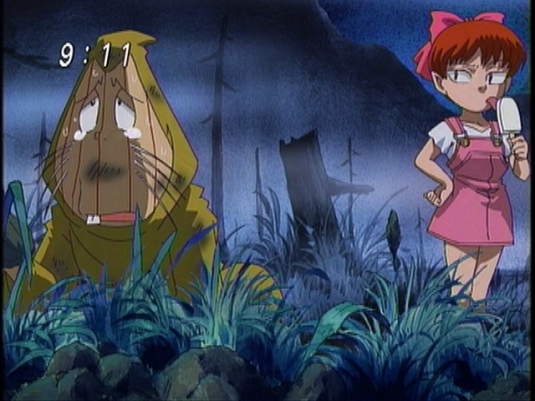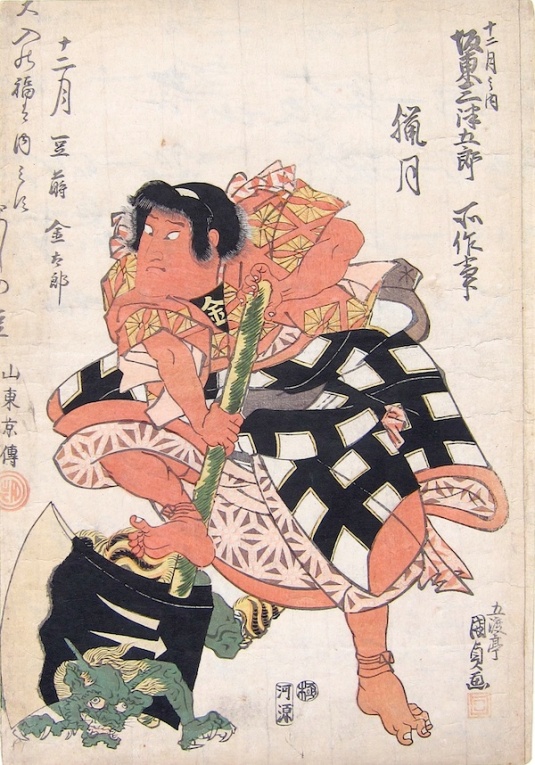Half human. Half yokai. Hanyo have become a staple character in recent yokai comics and animation. But do they have roots in Japanese folklore?
The answer to that is a pretty resounding no. Hanyo are almost exclusively the creation of modern comic book artists and animators. More specifically, hanyo are the creation of Takahashi Rumiko, and to a lesser extent Mizuki Shigeru. While half-human/half-yokai children do exist in Japanese folklore, they are—with few exceptions—normal human beings. Whatever it is that makes a yokai, it doesn’t carry over to their half-human children.
What Does Hanyo Mean?
Hanyo is a neologism invented by Takahashi Rumiko for her comic book Inyuyasha. She took the kanji Han (半; half) and put it next to Yo (妖; apparition)—alternately spelled hanyou in an attempt to imitate the Japanese long vowel sound—to create a word for her concept of half-yokai characters. Takahashi has created an entire mythology around yokai, with variations depending on if their mother or father was a yokai, and attempts to become a full-blood human or yokai.
Mizuki Shigeru had earlier invented the term hanyokai (半妖怪; half-yokai) for his characters Nezumi Otoko and Neko Musume in his comic Gegege no Kitaro. In Mizuki Shigeru’s comics, the two hanyokai are in practice 100% yokai (Nezumi Otoko is over 360 years old, for example) and the term is used largely as an insult. Kitaro sometimes talks down to Nezumi Otoko for being only a hanyokai and not a true yokai. This was possibly mirroring the distaste for half-Japanese children when Gegege no Kitaro began, most of whom were the children of occupying U.S. soldiers and Japanese women.
It could also relate to Mizuki Shigeru’s theory of yokai being single-souled and humans having double-souls. Yokai being single-souled, focusing on whatever their task or motivation is—counting beans or whatever. Humans, and the other hand, were conflicted and at war with themselves. In Gegege no Kitaro, Nezumi Otoko is one of the few characters that “switches sides” between good and evil, possibly resulting from his human double-soul. But the same cannot be said for Neko Musume, who is squarely on Kitaro’s side. So this is just speculation. Maybe he just thought hanyokai sounded cool.
Half-Yokai/Half-Human in Japanese Folklore
The children of yokai and humans—and even yurei and humans—are relatively common in Japanese folklore. Almost all of these stories fall in the Magical Wife genre (I have never heard of a Magical Husband story). The stories follow a similar patter where a man performs some task/has an encounter, later a mysterious woman comes to be his wife provided he perform some condition like never speak of the previous encounter, never look in a box, etc … The couple live happily for several years, have some kids, and inevitably the husband breaks his promise and the Magical Wife leaves.
The most famous Magical Wife story is the tale of the Yuki Onna, where a snow demon comes upon two woodgatherers freezing in the forest. The Yuki Onna kills the older one, then falls in love with the younger. She eventually marries him as a human—under the condition that the husband never speak about his frozen encounter—has children and lives together many years. When the husband eventually gabs, the Yuki Onna flees, abandoning her children and spouse.
There are many, many more Magical Wife stories, like Hagoromo the Tennin and some about transformed animals and henge. There are stories where a dead woman’s yurei returns to her husband, take cares of him and bares his children, performing her wifely duties before she is able to return to the afterlife. The one thing these stories have in common is that the children from these mystical mash-ups are all normal, human children.
(The Magical Wife genre is popular in Western folktales as well, popular enough that it has its own classification under the Aarne–Thompson classification system—#402 The Animal Bride.)
The Exceptions—Kintaro and Abe no Seimei
There are always exceptions. In this case, there are two of them, although only one could really be called a hanyo or hanyokai.
Kintaro the Nature Boy is one of Japan’s most famous and popular folkloric figures. Incredibly strong even as a baby, and friends with the bears of the woods, there are multiple variations of his origins. In one of them, his mother the Princess Yaegiri became pregnant when the Red Dragon god of Mt. Ashigara sent a clap of thunder to her. This is not the most common origin for Kintaro—most stories have his mother fleeing some conflict while pregnant and giving birth in the mountains. And even then, with a Red Dragon as a father Kintaro would more properly be a hanshin, a demi-god, and not a hanyo.
Abe no Seimei is the other exception. A real person, Abe no Seimei was a famous onmyoji ying/yang sorcerer during the Heian period. He has since passed into folklore, and it is difficult to separate the fact from the legend when it comes to Abe no Seimei. One of the legends, however, is that his mother Kuzunoha was a kitsume, a magical fox.
The legend states that Abe no Yasuna came upon a hunter trapping a fox. Yasuna battled the hunter and won, and set the fox free. A beautiful woman named Kuzunoha appeared to tend his wounds, and the two fell in love and married. Their child Seimei was born, who was exceedingly bright. One day, while Kuzunoha was watching chrysanthemums, a young Seimei saw a piece of fox tail poking out from her kimono. The spell broken, Kuzunoha the fox returned to the forest, leaving her son behind but granting him a piece of her magical powers. This makes Abe no Seimei the only true hanyo in Japanese folklore.
The Children of Ubume
There is one more semi-exception. Ubume are a specialized type of yurei, who die while pregnant leading to a still-living child being born from a dead body. Ubume are ghost mothers who come back to tend for their living child, who is often trapped in a coffin buried under the earth. By some legends, the children of these ubume are special, often faster and stronger than normal humans.
The most famous ubume child is, of course, Kitaro from Gegege no Kitaro.
Translator’s Note:
I wrote this because I get asked fairly often about hanyo, mostly from fans of Inyuyasha who want to know how authentic Takahashi Rumiko’s use of Japanese folklore is. The answer is “not very.” She creates her own worlds with her own mythologies. But her creation of hanyo has proved popular enough to crop up in other comics as well, like Rise of the Nura Clan and Maiden Spirit Zakuro.
However, true human-hybrids are exceedingly rare in Japanese mythology and folklore.
Further Reading:
For more stories from Hyakumonogatari.com, check out:









May 07, 2013 @ 07:52:21
It seems to me, in theory anyway that if some of these children have powers while others don’t, that means the ‘normal’ hybrid children are only normal due to a binding.
Perhaps there is an un-spoken rule about how much these children are allowed to manifest their Yokai powers and exceptions are rare.
May 07, 2013 @ 09:38:56
I don’t think so. Seeing as their is only one real exception in the history of Japan–and even then, Abe no Seimei didn’t inherit his powers but was given them as a gift from his departing mother, I think it is safe to say that yokai/human children never naturally manifest any powers. They are 100% human. The yokai heritage doesn’t carry through.
Hanyo as a concept are more like Mutants in X-Men, just a convenient way to explain a super-powered character in comic books.
May 08, 2013 @ 12:11:00
In Minekura Kazuya’s Saiyuki, the existence of hanyo is a dramatic device used to explore the distrust and prejudice between humans and yokai. Hanyo have no yokai powers but they do have a distinctive appearance – bright red hair and eyes – so you can always tell when a kid is one, and of course they never fit in on either side of the divide and great is the angst therefrom.
May 08, 2013 @ 13:01:04
Interesting. I have never read Saiyuki, but it was mentioned on Japanese Wikipedia as a comic that uses hanyo as characters. It sounds like the artist is using them a s a sort of metaphor, one that would be familiar to all half-children in Japan. They are marked as distinctively “not-Japanese” by their looks, and often held apart from society.
May 12, 2013 @ 23:32:47
In the anime film “Ookami kodomo no Ame to Yuki´´ the main characters are 2 children, who are born from the union between a human woman and an Ookami, a Youkai wolf that can transform into a human man. Due to this. their children are han’you and they can transform into a wolf too.
May 14, 2013 @ 11:56:41
I don’t know that film, but yes … many comic and anime use hanyo characters nowadays. Even though they aren’t “traditional folklore,” you could say they have been added to “modern folklore” via comic book culture.
Sep 02, 2013 @ 13:05:22
Interesting article. Relating to your comments on Kintaro, what would you think about Momotaro? In the version of the story I read, he hatched from a giant peach and had super strength. I don’t think he’d really count as a hanshin, like you labeled Kintaro, but his origin (at least the one I read) doesn’t specifically mention any yokai, either. Would Momotaro be another special case?
Sep 08, 2013 @ 19:12:38
Momotaro is pretty unique, like Issun-bōsh (The Inch-High Samurai). Neither of them have any special designations–they were gifts from the gods to childless older couples.
But that is a good point that not all folklore fits in nice little categories. Storytellers aren’t bound by any rules other than their imaginations, and can make up what they want.
Sep 24, 2013 @ 18:57:07
That’s true, storytellers do change things around depending on the kind of story they want to tell. The idea of giving hanyō powers almost seems reminiscent of what Rick Riordan did with demigods in his “Percy Jackson” series. In those books, demigods tend to have powers associated with their god-parent, such as Poseidon’s children being able to manipulate water, while demigods in myths were usually just really strong heroes. Both cases are an interesting interpretation, to say the least.
Jul 01, 2014 @ 11:13:13
Um, technically they do exist (besides Kintaro) if you count the stories where Kitsune marry human men and bear children. Of course, I don’t really know the semantics of that.
Jul 05, 2014 @ 18:29:32
Like I said in the article, there are lots of children of yokai/human parents, but the children are 100% human. They inherit nothing of their yokai parents abilities/nature.
Oct 21, 2020 @ 15:26:57
Hanyou is the proper modified Hepburn spelling. The alternative is hanyō (if the special character fails to display that’s a letter o with a macron). Hanyo is not a correct transliteration.
Oct 21, 2020 @ 16:12:25
That is correct if you are doing a transliteration. But what I do is translation. The same reason we say Tokyo instead of Toukyou.